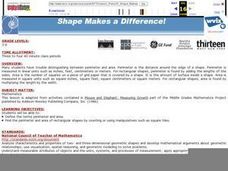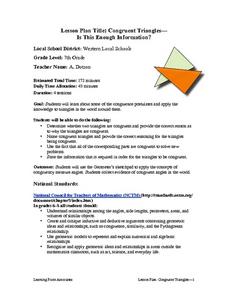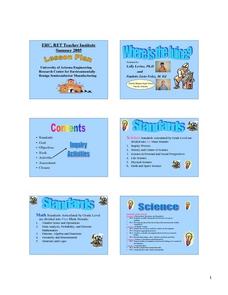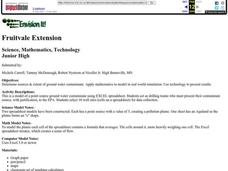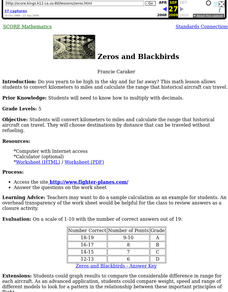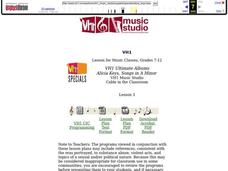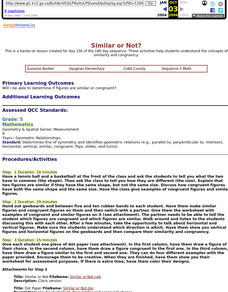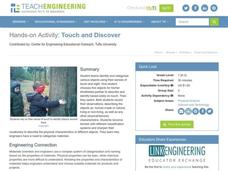Curated OER
Round to the Nearest Whole $
For this rounding money worksheet, students identify the money amounts in each examples and round to the nearest dollar for the 10 examples.
Curated OER
Geometry Scavenger Hunt
Pupils use the digital camera, identify geometric shapes (in nature as well as man-made), and gain a better understanding of geometric vocabulary. They search for and recognize geometric shapes in unusual settings
Curated OER
Are You Absolutely Sure of the Value?
Seventh graders develop an examineing of absolute value through real world situations. They develop an examineing of when absolute value can be used in a given situation.
Curated OER
Angles and Parallel Lines
Sixth graders draw parallel and intersecting lines to observe and examine the characteristics of alternate interior angles, vertical angles, corresponding angles, and supplementary angles. Through observation, they discover the...
Curated OER
Angle Benchmarks
Sixth graders discuss the characteristics of specific angles and then use the information to to identify and estimate given angles. The class goes outside, identifies north, and turns a specified amount of degrees. Using a given compass,...
Curated OER
1 VS the Mob
Students prepare to become the first to cover four adjacent products, horizontally, vertically or diagonally by selecting factors that make the needed products. They play this game to acquire a healthy appetite for competition between...
Curated OER
Menu Mania
Students explore the concept of estimating by watching a video, and discussing the strategies for estimation. They estimate the costs for various menu items, then calculate the exact amount spent.
Curated OER
Best Guesser
Fifth graders develop strategies for estimating ages, and illustrate results by graphing and interpreting scatter plots to compare x and y coordinates.
Curated OER
Inventors Timelines
Students create a class timeline using the patent year for their selected inventor or invention. Using a piece of yarn, they physically create a timeline, and create and answer math word problems using the years from the timeline.
Curated OER
Drive-In Multiplication
In this multiplication activity, students read about a mechanic's list of cars scheduled to have tires changed. They also see a chart outlining that week's work. Students then answer the 7 questions regarding the mechanic's week of work.
Curated OER
Shape Makes a Difference!
Students learn the difference between perimeter and area by watching a video and a hands on activity.
Curated OER
Calendar -- Months of the Year
First graders study the months of the year. They enjoy making a class book using their birthdays and the types of weather in that month. After a lecture/demo, 1st graders utilize a worksheet imbedded in this plan to design their book.
Curated OER
Congruent Triangles - Is This Enough Information?
Seventh graders examine congruence postulates and apply knowledge to triangles in the world around them.
Curated OER
Where Is The Juice?
Students are introduced to the component's of Ohm's Law. In groups, they practice their problem solving skills by reviewing problems solved earlier. They participate in activities that help them gather information on the importance of...
Canton Museum of Art
Personal Clay Box
High schoolers will love this geometrically exact ceramics project; they create a personalized clay box using the slab method and mathematical measurements. They utilize scoring and square construction and can decorate the boxes to...
Curated OER
Fruitvale Extension
Students determine sources and extent of ground water contaminate, apply mathematics to model in real world simulation, and use technology to present results.
Curated OER
Zeros and Blackbirds
Fifth graders convert kilometers to miles and calculate the range that historical aircraft can travel. They choose destinations by distance that can be traveled without refueling.
Curated OER
Owl Pellets: A Fowl-Up, Chuck!
Young scholars discover the world of owls as predators. After watching a video of owls hunting and eating, are introduced to owl pellets. Students dissect their own pellet and match the prey's bones to a bone diagram.
Curated OER
Mapping India
Students participate in an activity in which they place placards listing geographic features, landmarks, etc. in the correct place on a large fabric map of a given country. They also examine artifacts, photos, sounds/music, etc. from...
Curated OER
Alicia Keys, Songs in A Minor
Students watch a video about Alicia Keys and discuss the business side of her career. Groups role-play producers for her new album taking on the responsibility for all aspects, including budgets, contracts, song production, and advertising.
Curated OER
Months
First graders work in pairs to create a class big book for months of the year. They work together to create a detailed version of their month that includes any special holidays and activities.
Curated OER
Similar or Not?
Fifth graders define the meaning of similar and congruent using concrete objects. They make similar and congruent figures using geoboards. They draw their figures on dot paper, and color their designs.
Curated OER
Touch and Discover
Students work together to identify and categorize objects. They have to identify the object on touch because they are blindfolded. They record their data and describe the objects once they can look at them.










